technical data SKODA FABIA 2010 2.G / 5J Repair Manual
[x] Cancel search | Manufacturer: SKODA, Model Year: 2010, Model line: FABIA, Model: SKODA FABIA 2010 2.G / 5JPages: 244, PDF Size: 29.53 MB
Page 122 of 244
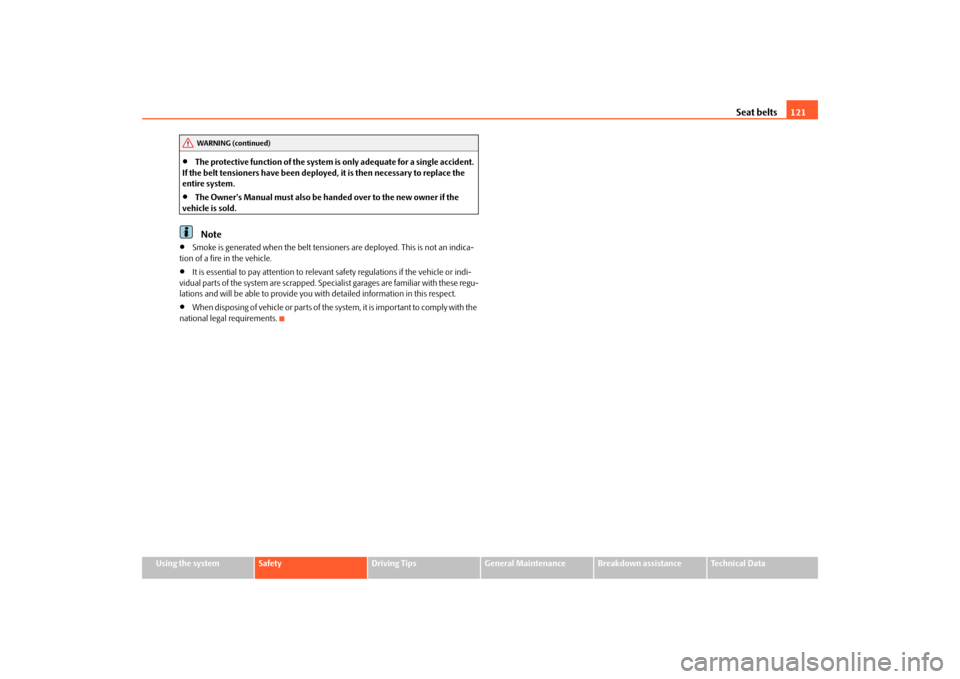
Seat belts
121
Using the system
Safety
Driving Tips
General Maintenance
Breakdown assistance
Technical Data
The protective function of the system is
only adequate for a single accident.
If the belt tensioners have been deployed, it is then necessary to replace the entire system.
The Owner's Manual must also be handed over to the new owner if the
vehicle is sold.
Note
Smoke is generated when the belt tensione
rs are deployed. This is not an indica-
tion of a fire in the vehicle.
It is essential to pay attent
ion to relevant safety regulations if the vehicle or indi-
vidual parts of the system are scrapped. Specialist garages are familiar with these regu- lations and will be able to provide you with detailed information in this respect.
When disposing of vehicle or parts of the system, it is important to comply with the
national legal requirements.
WARNING (continued)
s3j8.a.book Page 121 Tuesday, April 20, 2010 1:10 PM
Page 124 of 244
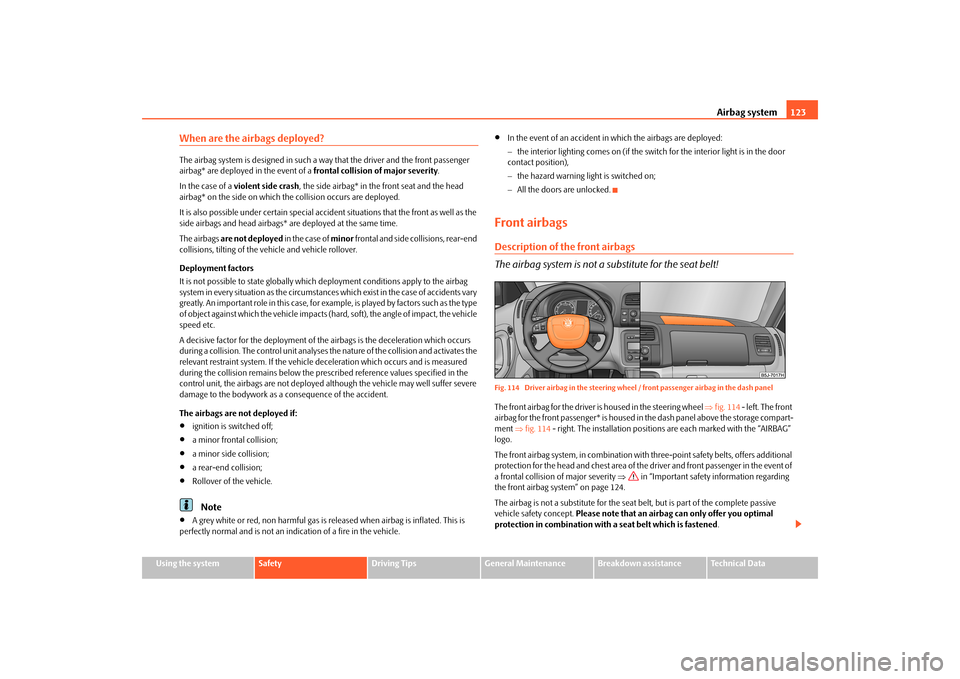
Airbag system
123
Using the system
Safety
Driving Tips
General Maintenance
Breakdown assistance
Technical Data
When are the airbags deployed?The airbag system is designed in such a
way that the driver and the front passenger
airbag* are deployed in the event of a
frontal collision of major severity
.
In the case of a
violent side crash
, the side airbag* in the front seat and the head
airbag* on the side on which the collision occurs are deployed. It is also possible under certain special accident situations that the front as well as the side airbags and head airbags* are deployed at the same time. The airbags
are not deployed
in the case of
minor
frontal and side collisions, rear-end
collisions, tilting of the ve
hicle and vehicle rollover.
Deployment factors It is not possible to state globally which
deployment conditions apply to the airbag
system in every situation as the circumstances which exist in the case of accidents vary greatly. An important role in this case, for ex
ample, is played by factors such as the type
of object against which the vehicle impacts (h
ard, soft), the angle of impact, the vehicle
speed etc. A decisive factor for the deployment of the airbags is the deceleration which occurs during a collision. The control unit analyses
the nature of the collision and activates the
relevant restraint system. If the vehicle deceleration which occurs and is measured during the collision remains below the prescribed reference values specified in the control unit, the airbags are no
t deployed although the vehicle may well suffer severe
damage to the bodywork as a consequence of the accident. The airbags are not deployed if:
ignition is switched off;
a minor frontal collision;
a minor side collision;
a rear-end collision;
Rollover of the vehicle.Note
A grey white or red, non harmful gas is released when airbag is inflated. This is
perfectly normal and is not an indi
cation of a fire in the vehicle.
In the event of an accident in which the airbags are deployed: the interior lighting comes on (if the swit
ch for the interior light is in the door
contact position), the hazard warning li
ght is switched on;
All the doors are unlocked.
Front airbagsDescription of the front airbags The airbag system is not a su
bstitute for the seat belt!
Fig. 114 Driver airbag in the steering wheel
/ front passenger airbag in the dash panel
The front airbag for the driver is housed in the steering wheel
fig. 114
- left. The front
airbag for the front passenger* is housed in the dash panel above the storage compart- ment
fig. 114
- right. The installation positions are each marked with the “AIRBAG”
logo. The front airbag system, in combination with
three-point safety belts, offers additional
protection for the head and chest area of the driver and front passenger in the event of a frontal collision of major severity
in “Important safety information regarding
the front airbag system” on page 124. The airbag is not a substitute for the seat
belt, but is part of the complete passive
vehicle safety concept.
Please note that an airbag can only offer you optimal
protection in combination with a seat belt which is fastened
.
s3j8.a.book Page 123 Tuesday, April 20, 2010 1:10 PM
Page 126 of 244
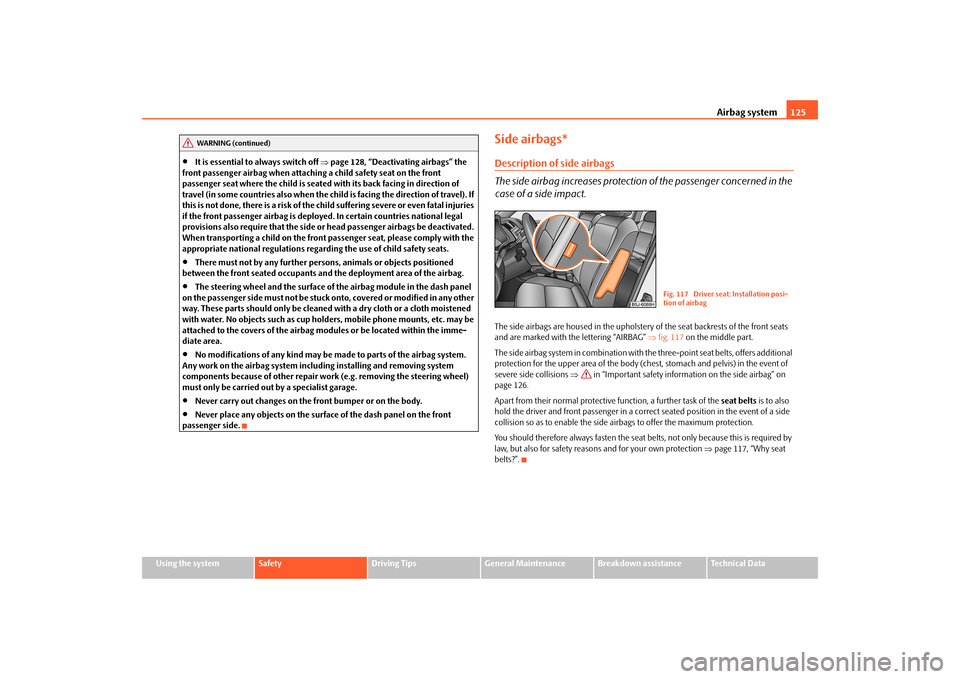
Airbag system
125
Using the system
Safety
Driving Tips
General Maintenance
Breakdown assistance
Technical Data
It is essential to always switch off
page 128, “Deactivating airbags” the
front passenger airbag when attaching a child safety seat on the front passenger seat where the child is seated
with its back facing in direction of
travel (in some countries also
when the child is facing the direction of travel). If
this is not done, there is a risk of the ch
ild suffering severe or even fatal injuries
if the front passenger airbag is deploy
ed. In certain countries national legal
provisions also require that the side or
head passenger airbags be deactivated.
When transporting a child on the front passenger seat, please comply with the appropriate national regu
lations regarding the use of child safety seats.
There must not by any further persons, animals or objects positioned
between the front seated occupants and
the deployment area of the airbag.
The steering wheel and the surface of th
e airbag module in the dash panel
on the passenger side must not be stuck
onto, covered or modified in any other
way. These parts should only be cleaned with a dry cloth or a cloth moistened with water. No objects such as cup holders, mobile phone mounts, etc. may be attached to the covers of the airbag modules or be located within the imme- diate area.
No modifications of any kind may be
made to parts of the airbag system.
Any work on the airbag system includ
ing installing and removing system
components because of other repair wo
rk (e.g. removing the steering wheel)
must only be carried out by a specialist garage.
Never carry out changes on the front bumper or on the body.
Never place any objects on the surface of the dash panel on the front
passenger side.
Side airbags*Description of side airbags The side airbag increases protection
of the passenger concerned in the
case of a side impact.The side airbags are housed in the upholstery of the seat backrests of the front seats and are marked with the lettering “AIRBAG”
fig. 117
on the middle part.
The side airbag system in combination with the three-point seat belts, offers additional protection for the upper area of the body
(chest, stomach and pelvis) in the event of
severe side collisions
in “Important safety information on the side airbag” on
page 126. Apart from their normal protective function, a further task of the
seat belts
is to also
hold the driver and front pass
enger in a correct seated position in the event of a side
collision so as to enable the side ai
rbags to offer the maximum protection.
You should therefore always fasten the seat belts, not only because this is required by law, but also for safety reasons and for your own protection
page 117, “Why seat
belts?”.
WARNING (continued)
Fig. 117 Driver seat: Installation posi- tion of airbag
s3j8.a.book Page 125 Tuesday, April 20, 2010 1:10 PM
Page 128 of 244
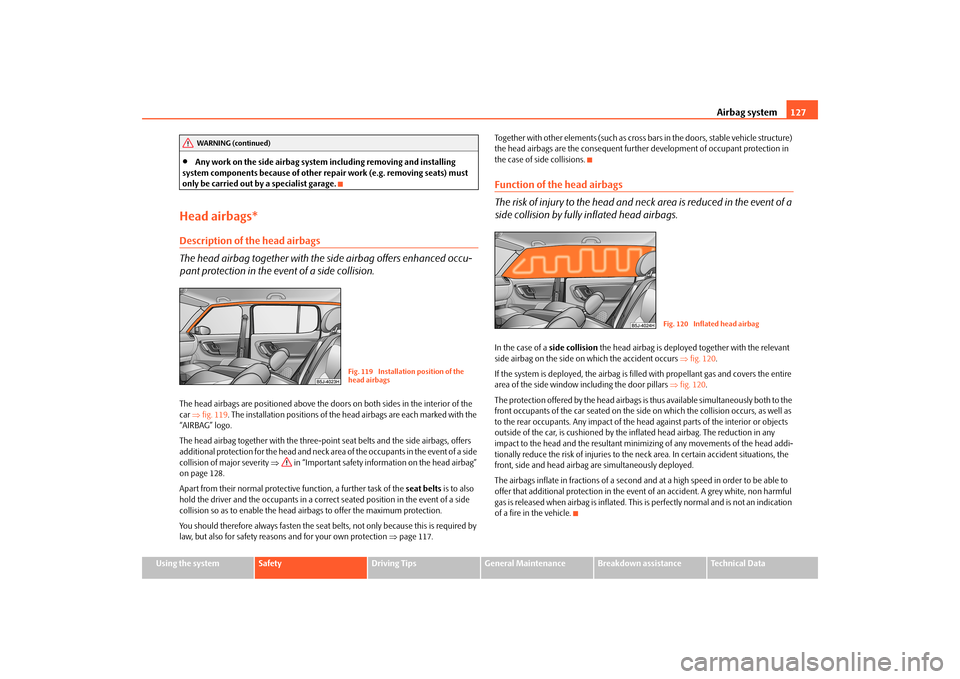
Airbag system
127
Using the system
Safety
Driving Tips
General Maintenance
Breakdown assistance
Technical Data
Any work on the side airbag system including removing and installing
system components because of other repair work (e.g. removing seats) must only be carried out by a specialist garage.Head airbags*Description of the head airbags The head airbag together with the
side airbag offers enhanced occu-
pant protection in the event of a side collision.The head airbags are positioned above the d
oors on both sides in the interior of the
car
fig. 119
. The installation positions of the head airbags are each marked with the
“AIRBAG” logo. The head airbag together with the three-poin
t seat belts and the side airbags, offers
additional protection for the head and neck area of the occupants in the event of a side collision of major severity
in “Important safety information on the head airbag”
on page 128. Apart from their normal protective function, a further task of the
seat belts
is to also
hold the driver and the occupants in a correc
t seated position in the event of a side
collision so as to enable the head ai
rbags to offer the maximum protection.
You should therefore always fasten the seat
belts, not only because this is required by
law, but also for safety reasons and for your own protection
page 117.
Together with other elements (such as cross bars in the doors, stable vehicle structure) the head airbags are the consequent further development of occupant protection in the case of side collisions.Function of the head airbags The risk of injury to the head and ne
ck area is reduced in the event of a
side collision by fully inflated head airbags.In the case of a
side collision
the head airbag is deployed together with the relevant
side airbag on the side on which the accident occurs
fig. 120
.
If the system is deployed, the airbag is fille
d with propellant gas and covers the entire
area of the side window
including the door pillars
fig. 120
.
The protection offered by the head airbags is
thus available simultaneously both to the
front occupants of the car seated on the side
on which the collision occurs, as well as
to the rear occupants. Any impact of the he
ad against parts of the interior or objects
outside of the car, is cushioned by the in
flated head airbag. The reduction in any
impact to the head and the resultant minimi
zing of any movements of the head addi-
tionally reduce the risk of in
juries to the neck
area. In certain accide
nt situations, the
front, side and head airbag are simultaneously deployed. The airbags inflate in fractions of a second an
d at a high speed in order to be able to
offer that additional protection in the event of an accident. A grey white, non harmful gas is released when airbag is inflated. This
is perfectly normal and is not an indication
of a fire in the vehicle.
WARNING (continued)
Fig. 119 Installation position of the head airbags
Fig. 120 Inflated head airbag
s3j8.a.book Page 127 Tuesday, April 20, 2010 1:10 PM
Page 130 of 244
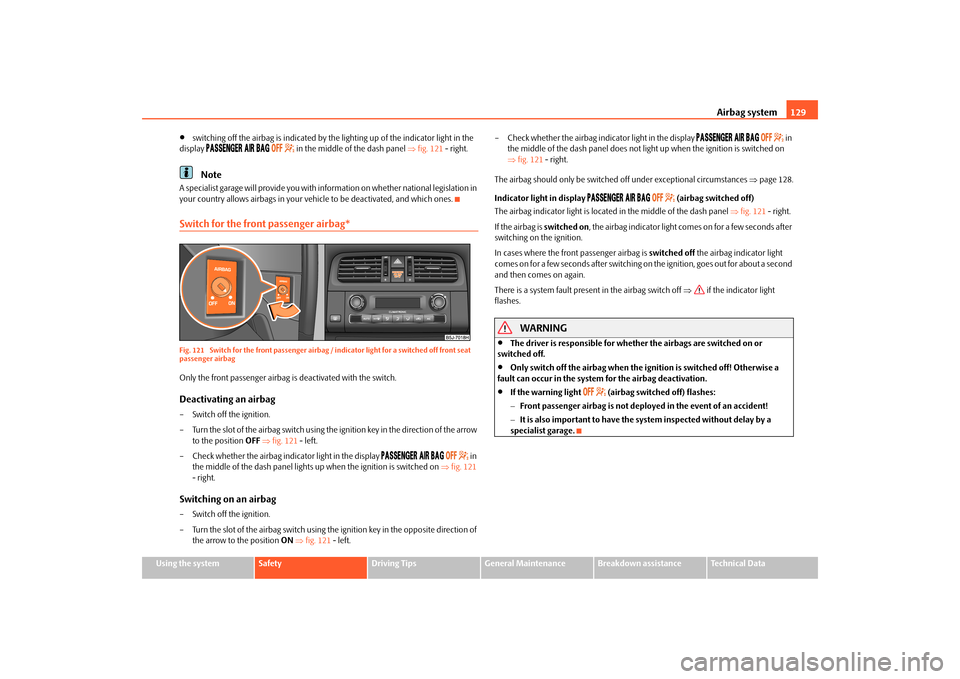
Airbag system
129
Using the system
Safety
Driving Tips
General Maintenance
Breakdown assistance
Technical Data
switching off the airbag is indicated by the
lighting up of the indicator light in the
display
in the middle of the dash panel
fig. 121
- right.
Note
A specialist garage will provide you with in
formation on whether na
tional legislation in
your country allows airbags in your vehi
cle to be deactivated, and which ones.
Switch for the front passenger airbag*Fig. 121 Switch for the front passenger airbag
/ indicator light for a switched off front seat
passenger airbagOnly the front passenger airbag is deactivated with the switch.Deactivating an airbag– Switch off the ignition. – Turn the slot of the airbag switch using the ignition key in the direction of the arrow
to the position
OFF
fig. 121
- left.
– Check whether the airbag indicator light in the display
in
the middle of the dash panel lights up when the ignition is switched on
fig. 121
- right.
Switching on an airbag– Switch off the ignition. – Turn the slot of the airbag switch using the ignition key in the opposite direction of
the arrow to the position
ON
fig. 121
- left.
– Check whether the airbag indicator light in the display
in
the middle of the dash panel does not light up when the ignition is switched on fig. 121
- right.
The airbag should only be switched
off under exceptional circumstances
page 128.
Indicator light in display
(airbag switched off)
The airbag indicator light is located in the middle of the dash panel
fig. 121
- right.
If the airbag is
switched on
, the airbag indicator light comes on for a few seconds after
switching on the ignition. In cases where the front passenger airbag is
switched off
the airbag in
dicator light
comes on for a few seconds after switching on the ignition, goes out for about a second and then comes on again. There is a system fault present in the airbag switch off
if the indicator light
flashes.
WARNING
The driver is responsible for whethe
r the airbags are switched on or
switched off.
Only switch off the airbag when the ignition is switched off! Otherwise a
fault can occur in the system for the airbag deactivation.
If the warning light
(airbag switched off) flashes:
Front passenger airbag is not deployed in the event of an accident! It is also important to have the system inspected without delay by a specialist garage.
s3j8.a.book Page 129 Tuesday, April 20, 2010 1:10 PM
Page 132 of 244
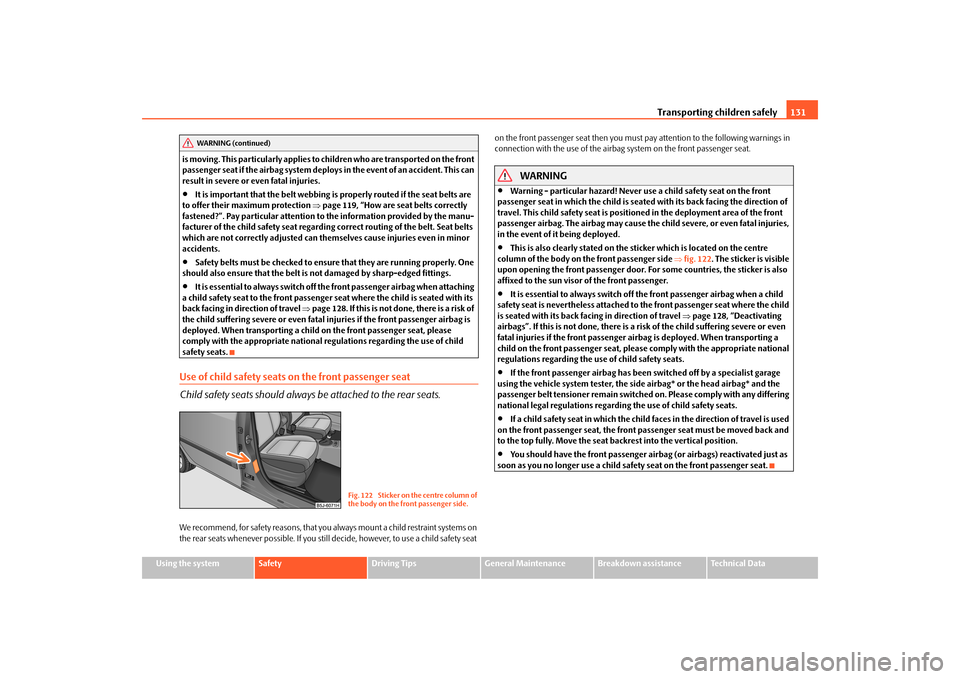
Transporting children safely
131
Using the system
Safety
Driving Tips
General Maintenance
Breakdown assistance
Technical Data
is moving. This particularly applies to children who are transported on the front passenger seat if the airbag system deploy
s in the event of an accident. This can
result in severe or even fatal injuries.
It is important that the belt webbing is properly routed if the seat belts are
to offer their maximum protection
page 119, “How are seat belts correctly
fastened?”. Pay particular attention to the information provided by the manu-facturer of the child safety seat regarding correct routing of the belt. Seat belts which are not correctly adjusted can them
selves cause injuries even in minor
accidents.
Safety belts must be checked to ensure that they are running properly. One
should also ensure that the belt is
not damaged by sharp-edged fittings.
It is essential to always switch off th
e front passenger airbag when attaching
a child safety seat to the front passenger
seat where the child is seated with its
back facing in direction of travel
page 128. If this is not done, there is a risk of
the child suffering severe or even fatal in
juries if the front passenger airbag is
deployed. When transporting a child
on the front passenger seat, please
comply with the appropriate national
regulations regarding the use of child
safety seats.Use of child safety seats on the front passenger seat Child safety seats should always
be attached to the rear seats.
We recommend, for safety reasons, that you always mount a child restraint systems on the rear seats whenever possible. If you still decide, however, to use a child safety seat
on the front passenger seat then you must pay attention to the following warnings in connection with the use of the airbag system on the front passenger seat.
WARNING
Warning - particular hazard! Never use a child safety seat on the front
passenger seat in which the child is seated
with its back facing the direction of
travel. This child safety seat is positioned in the deployment area of the front passenger airbag. The airbag may cause th
e child severe, or even fatal injuries,
in the event of it
being deployed.
This is also clearly stat
ed on the sticker which is located on the centre
column of the body on the front passenger side
fig. 122
. The sticker is visible
upon opening the front passenger door. For some countries, the sticker is also affixed to the sun visor of the front passenger.
It is essential to always switch off the front passenger airbag when a child
safety seat is nevertheless attached to
the front passenger seat where the child
is seated with its back facing in direction of travel
page 128, “Deactivating
airbags”. If this is not done, there is a ri
sk of the child suffering severe or even
fatal injuries if the front passenger airbag is deployed. When transporting a child on the front passenger seat, please comply with the appropriate national regulations regarding the use of child safety seats.
If the front passenger airbag has been
switched off by a specialist garage
using the vehicle system te
ster, the side airbag* or
the head airbag* and the
passenger belt tensioner re
main switched on. Please comply with any differing
national legal regulations regardin
g the use of child safety seats.
If a child safety seat in which the child faces in the direction of travel is used
on the front passenger seat, the front pa
ssenger seat must be moved back and
to the top fully. Move the seat backrest into the vertical position.
You should have the front passenger airbag (or airbags) reactivated just as
soon as you no longer use a child safe
ty seat on the front passenger seat.
WARNING (continued)
Fig. 122 Sticker on the centre column of the body on the front passenger side.
s3j8.a.book Page 131 Tuesday, April 20, 2010 1:10 PM
Page 134 of 244
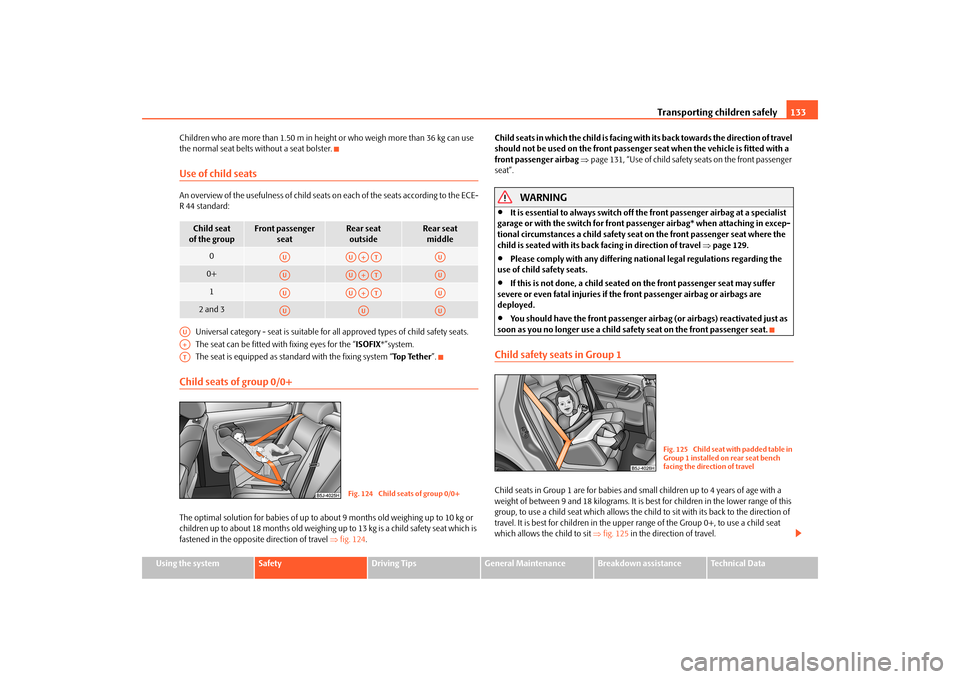
Transporting children safely
133
Using the system
Safety
Driving Tips
General Maintenance
Breakdown assistance
Technical Data
Children who are more than 1.50 m in height or who weigh more than 36 kg can use the normal seat belts without a seat bolster.Use of child seatsAn overview of the usefulness
of child seats on each of the seats according to the ECE-
R44 standard:
Universal category - seat is suitable for all approved types of child safety seats. The seat can be fitted with
fixing eyes for the “
ISOFIX
*”system.
The seat is equipped as standa
rd with the fixing system “
To p Te t h e r
”.
Child seats of group 0/0+The optimal solution for babies of up to ab
out 9 months old weighing up to 10 kg or
children up to about 18 months old weighing up
to 13 kg is a child safety seat which is
fastened in the opposite direction of travel
fig. 124
.
Child seats in which the child is facing with its back towards the direction of travel should not be used on the front passenger seat when the vehicle is fitted with a front passenger airbag
page 131, “Use of child safety seats on the front passenger
seat”.
WARNING
It is essential to always switch off the front passenger airbag at a specialist
garage or with the switch for front pass
enger airbag* when attaching in excep-
tional circumstances a child safety seat on the front passenger seat where the child is seated with its back facing in direction of travel
page 129.
Please comply with any differing nati
onal legal regulations regarding the
use of child safety seats.
If this is not done, a child seated on
the front passenger seat may suffer
severe or even fatal injuries if the
front passenger airbag or airbags are
deployed.
You should have the front passenger airbag (or airbags) reactivated just as
soon as you no longer use a child safe
ty seat on the front passenger seat.
Child safety seats in Group 1Child seats in Group 1 are for babies and sm
all children up to 4 years of age with a
weight of between 9 and 18 kilograms. It is
best for children in the lower range of this
group, to use a child seat which allows the ch
ild to sit with its back to the direction of
travel. It is best for children in the uppe
r range of the Group 0+, to use a child seat
which allows the child to sit
fig. 125
in the direction of travel.
Child seat of the group
Front passenger
seat
Rear seat outside
Rear seat middle
0
0+
1
2 and 3
AU
AUA+AT
AU
AU
AUA+AT
AU
AU
AUA+AT
AU
AU
AU
AU
AUA+AT
Fig. 124 Child seats of group 0/0+
Fig. 125 Child seat with padded table in Group 1 installed on rear seat bench facing the direction of travel
s3j8.a.book Page 133 Tuesday, April 20, 2010 1:10 PM
Page 136 of 244
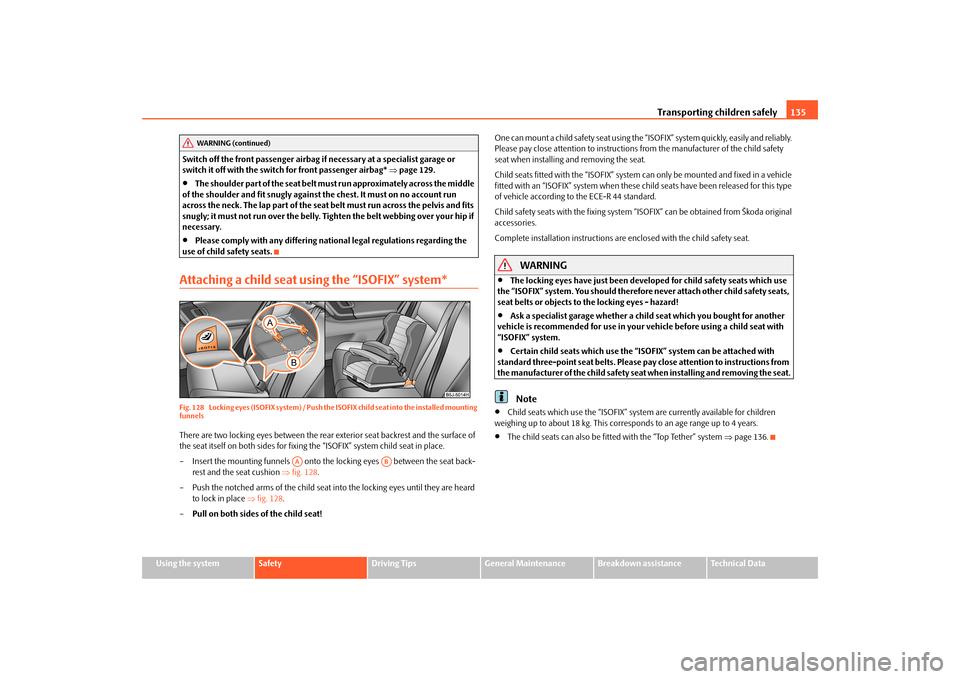
Transporting children safely
135
Using the system
Safety
Driving Tips
General Maintenance
Breakdown assistance
Technical Data
Switch off the front passenger airbag if
necessary at a specialist garage or
switch it off with the switch for front passenger airbag*
page 129.
The shoulder part of the seat belt mu
st run approximatel
y across the middle
of the shoulder and fit snugly against the chest. It must on no account run across the neck. The lap part of the seat belt must run across the pelvis and fits snugly; it must not run over the belly. Tighten the belt webbing over your hip if necessary.
Please comply with any differing nati
onal legal regulations regarding the
use of child safety seats.Attaching a child seat using the “ISOFIX” system*Fig. 128 Locking eyes (ISOFIX system) / Push the
ISOFIX child seat into the installed mounting
funnelsThere are two locking eyes between the rear
exterior seat backrest and the surface of
the seat itself on both sides for fixing the “ISOFIX” system child seat in place. – Insert the mounting funnels onto the
locking eyes between the seat back-
rest and the seat cushion
fig. 128
.
– Push the notched arms of the child seat in
to the locking eyes until they are heard
to lock in place
fig. 128
.
–
Pull on both sides of the child seat!
One can mount a child safety seat using the “ISOFIX” system quickly, easily and reliably. Please pay close attention to
instructions from the manufa
cturer of the child safety
seat when installing and removing the seat. Child seats fitted with the “ISOFIX” system
can only be mounted and fixed in a vehicle
fitted with an “ISOFIX” system when these child seats have been released for this type of vehicle according to the ECE-R 44 standard. Child safety seats with the fixing system “ISOFIX” can be obtained from Škoda original accessories. Complete installation instructions are
enclosed with the child safety seat.
WARNING
The locking eyes have just been deve
loped for child safety seats which use
the “ISOFIX” system. You should therefore
never attach other child safety seats,
seat belts or objects to the locking eyes - hazard!
Ask a specialist garage whether a child seat which you bought for another
vehicle is recommended for use in your
vehicle before using a child seat with
“ISOFIX” system.
Certain child seats which use the “ISO
FIX” system can be attached with
standard three-point seat belts. Please pay close attention to instructions from the manufacturer of the child safety seat
when installing and removing the seat.
Note
Child seats which use the “ISOFIX” system are currently available for children
weighing up to about 18 kg. This corres
ponds to an age range up to 4 years.
The child seats can also be fitted with the “Top Tether” system
page 136.
WARNING (continued)
AA
AB
s3j8.a.book Page 135 Tuesday, April 20, 2010 1:10 PM
Page 138 of 244
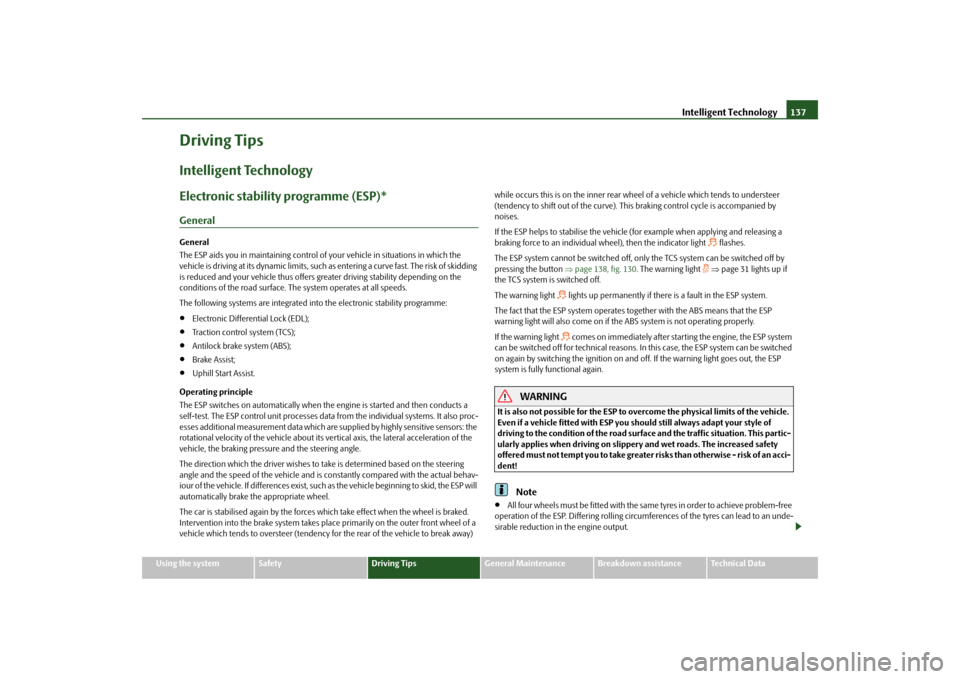
Intelligent Technology
137
Using the system
Safety
Driving Tips
General Maintenance
Breakdown assistance
Technical Data
Driving TipsIntelligent TechnologyElectronic stability programme (ESP)*GeneralGeneral The ESP aids you in maintaining control of
your vehicle in situations in which the
vehicle is driving at its dynamic limits, such as
entering a curve fast. The risk of skidding
is reduced and your vehicle thus offers greater driving stability depending on the conditions of the road surface. The system operates at all speeds. The following systems are integrated into the electronic stability programme:
Electronic Differential Lock (EDL);
Traction control system (TCS);
Antilock brake system (ABS);
Brake Assist;
Uphill Start Assist.
Operating principle The ESP switches on automati
cally when the engine is started and then conducts a
self-test. The ESP control unit processes data from the individual systems. It also proc- esses additional measurement data which are supplied by highly sensitive sensors: the rotational velocity of the vehicle about its ve
rtical axis, the lateral acceleration of the
vehicle, the braking pressure and the steering angle. The direction which the driver wishes to take is determined based on the steering angle and the speed of the vehicle and is co
nstantly compared wi
th the actual behav-
iour of the vehicle. If differences exist, such
as the vehicle beginning to skid, the ESP will
automatically brake the appropriate wheel. The car is stabilised again by the forces wh
ich take effect when the wheel is braked.
Intervention into the brake system takes place primarily on the outer front wheel of a vehicle which tends to oversteer (tendency fo
r the rear of the vehicle to break away)
while occurs this is on the inner rear wh
eel of a vehicle whic
h tends to understeer
(tendency to shift out of the curve). This braking control cycle is accompanied by noises. If the ESP helps to stabilise the vehicle (f
or example when applying and releasing a
braking force to an individual wheel), then the indicator light
flashes.
The ESP system cannot be switched off, only
the TCS system can be switched off by
pressing the button
page 138, fig. 130
. The warning light
page 31 lights up if
the TCS system is switched off. The warning light
lights up permanently if there is a fault in the ESP system.
The fact that the ESP system operates together with the ABS means that the ESP warning light will also come on if the ABS system is not operating properly. If the warning light
comes on immediately after starting the engine, the ESP system
can be switched off for technical reasons. In
this case, the ESP system can be switched
on again by switching the igni
tion on and off. If the warning light goes out, the ESP
system is fully functional again.
WARNING
It is also not possible for the ESP to overcome the physical limits of the vehicle. Even if a vehicle fitted with ESP you should still always adapt your style of driving to the condition of the road surfac
e and the traffic situation. This partic-
ularly applies when driving on slippery
and wet roads. The increased safety
offered must not tempt you to take greater risks than otherwise - risk of an acci- dent!
Note
All four wheels must be fitted with the same tyres in order to achieve problem-free
operation of the ESP. Differing rolling circum
ferences of the tyres can lead to an unde-
sirable reduction in the engine output.
s3j8.a.book Page 137 Tuesday, April 20, 2010 1:10 PM
Page 140 of 244
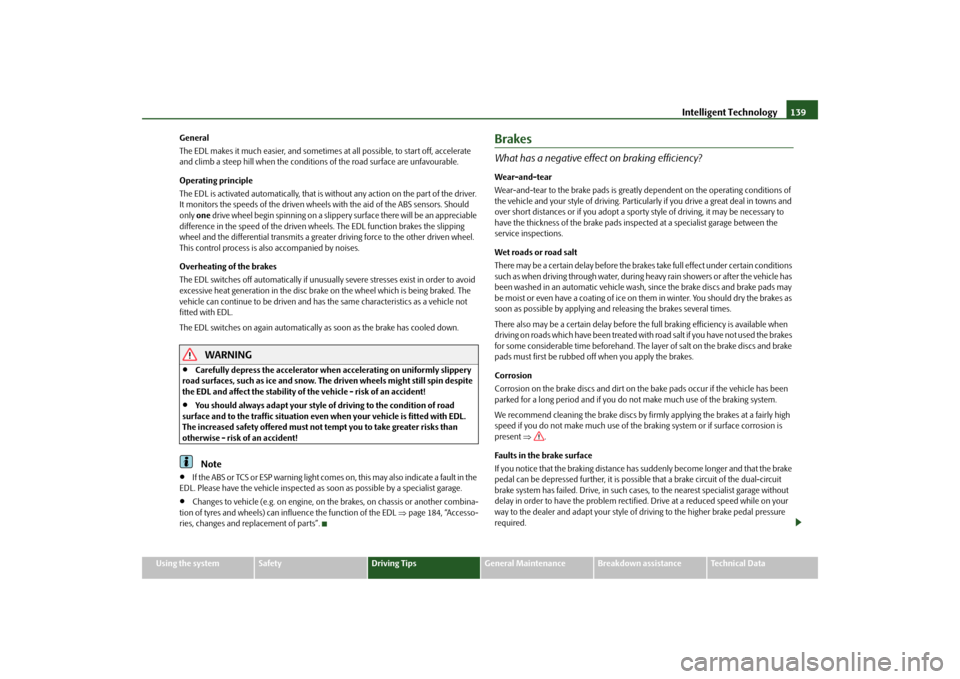
Intelligent Technology
139
Using the system
Safety
Driving Tips
General Maintenance
Breakdown assistance
Technical Data
General The EDL makes it much easier, and sometimes
at all possible, to start off, accelerate
and climb a steep hill when the conditions of the road surface are unfavourable. Operating principle The EDL is activated automaticall
y, that is without any action on the part of the driver.
It monitors the speeds of the driven wheels with the aid of the ABS sensors. Should only
one
drive wheel begin spinning on a slippery surface there will be an appreciable
difference in the speed of the driven wheels. The EDL function brakes the slipping wheel and the differential transmits a greate
r driving force to the other driven wheel.
This control process is also accompanied by noises. Overheating of the brakes The EDL switches off automatically if unusually severe stresses exist in order to avoid excessive heat generation in the disc brake on the wheel which is being braked. The vehicle can continue to be driven and has
the same characteristics as a vehicle not
fitted with EDL. The EDL switches on again automatically as soon as the brake has cooled down.
WARNING
Carefully depress the accelerator when accelerating on uniformly slippery
road surfaces, such as ice and snow. The driven wheels might still spin despite the EDL and affect the stability of
the vehicle - risk of an accident!
You should always adapt your style of driving to the condition of road
surface and to the traffic situation even
when your vehicle is fitted with EDL.
The increased safety offered must not tempt you to take greater risks than otherwise - risk of an accident!
Note
If the ABS or TCS or ESP warning light comes on, this may also indicate a fault in the
EDL. Please have the vehicle inspected as
soon as possible by a specialist garage.
Changes to vehicle (e.g. on engine, on th
e brakes, on chassis or another combina-
tion of tyres and wheels) can in
fluence the function of the EDL
page 184, “Accesso-
ries, changes and replacement of parts”.
BrakesWhat has a negative effect on braking efficiency?Wear-and-tear Wear-and-tear to the brake pa
ds is greatly dependent on
the operating conditions of
the vehicle and your style of driving. Particularly if you drive a great deal in towns and over short distances or if you adopt a sporty
style of driving, it may be necessary to
have the thickness of the brake pads insp
ected at a specialist garage between the
service inspections. Wet roads or road salt There may be a certain delay before the brakes
take full effect un
der certain conditions
such as when driving through water, during
heavy rain showers or
after the vehicle has
been washed in an automatic vehicle wash
, since the brake discs and brake pads may
be moist or even have a coating of ice on them in winter. You should dry the brakes as soon as possible by applying and
releasing the brakes several times.
There also may be a certain delay before the
full braking efficiency is available when
driving on roads which have been treated with
road salt if you have not used the brakes
for some considerable time beforehand. The
layer of salt on the brake discs and brake
pads must first be rubbed off when you apply the brakes. Corrosion Corrosion on the brake discs and dirt on th
e bake pads occur if
the vehicle has been
parked for a long period and if you do
not make much use of the braking system.
We recommend cleaning the brake discs by firm
ly applying the brakes at a fairly high
speed if you do not make much use of the braking system or if surface corrosion is present
.
Faults in the brake surface If you notice that the braking distance has
suddenly become longer and that the brake
pedal can be depressed further, it is possib
le that a brake circuit of the dual-circuit
brake system has failed. Drive, in such cases, to the nearest specialist garage without delay in order to have the problem rectified. Drive at a reduced speed while on your way to the dealer and adapt your style of
driving to the higher brake pedal pressure
required.
s3j8.a.book Page 139 Tuesday, April 20, 2010 1:10 PM